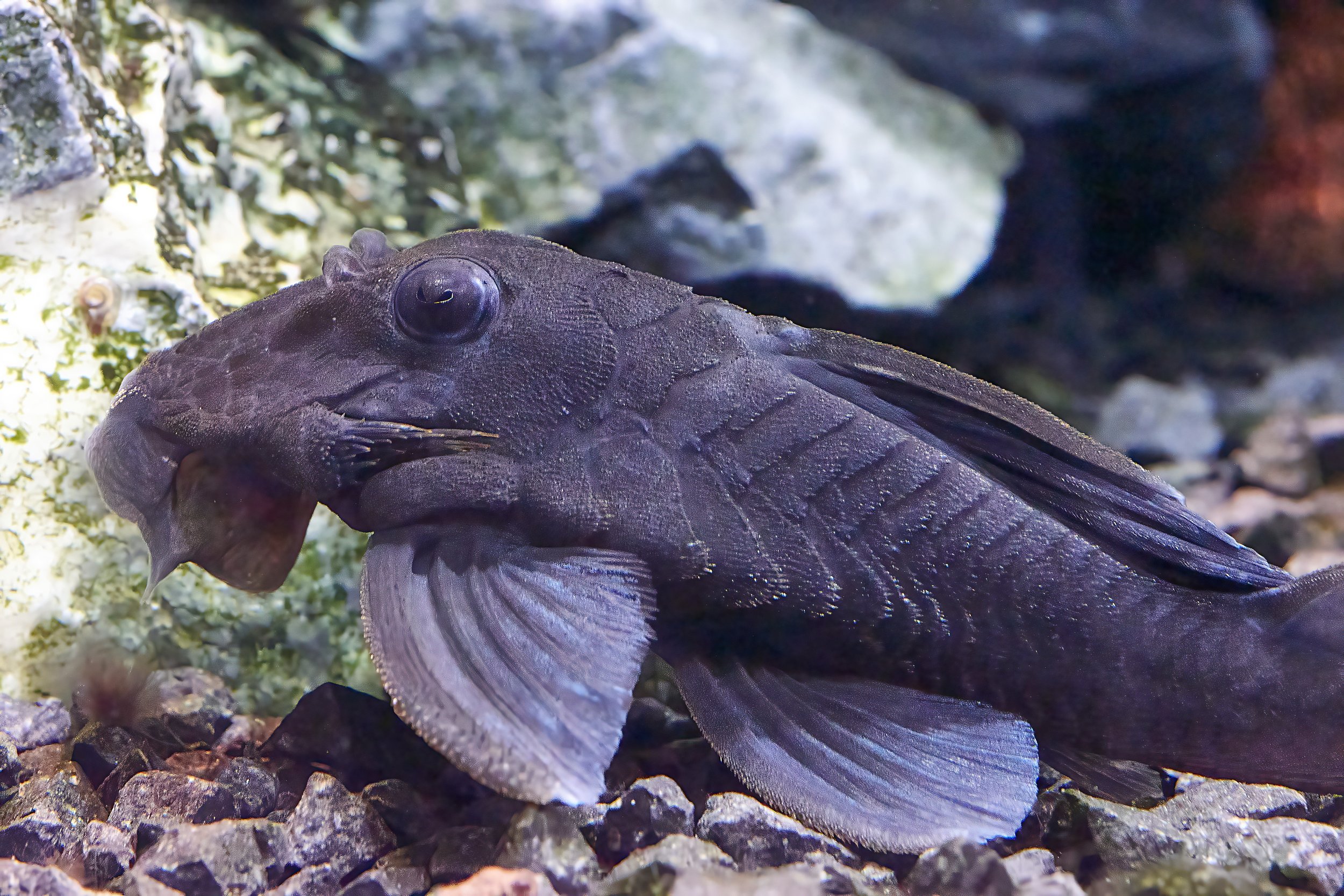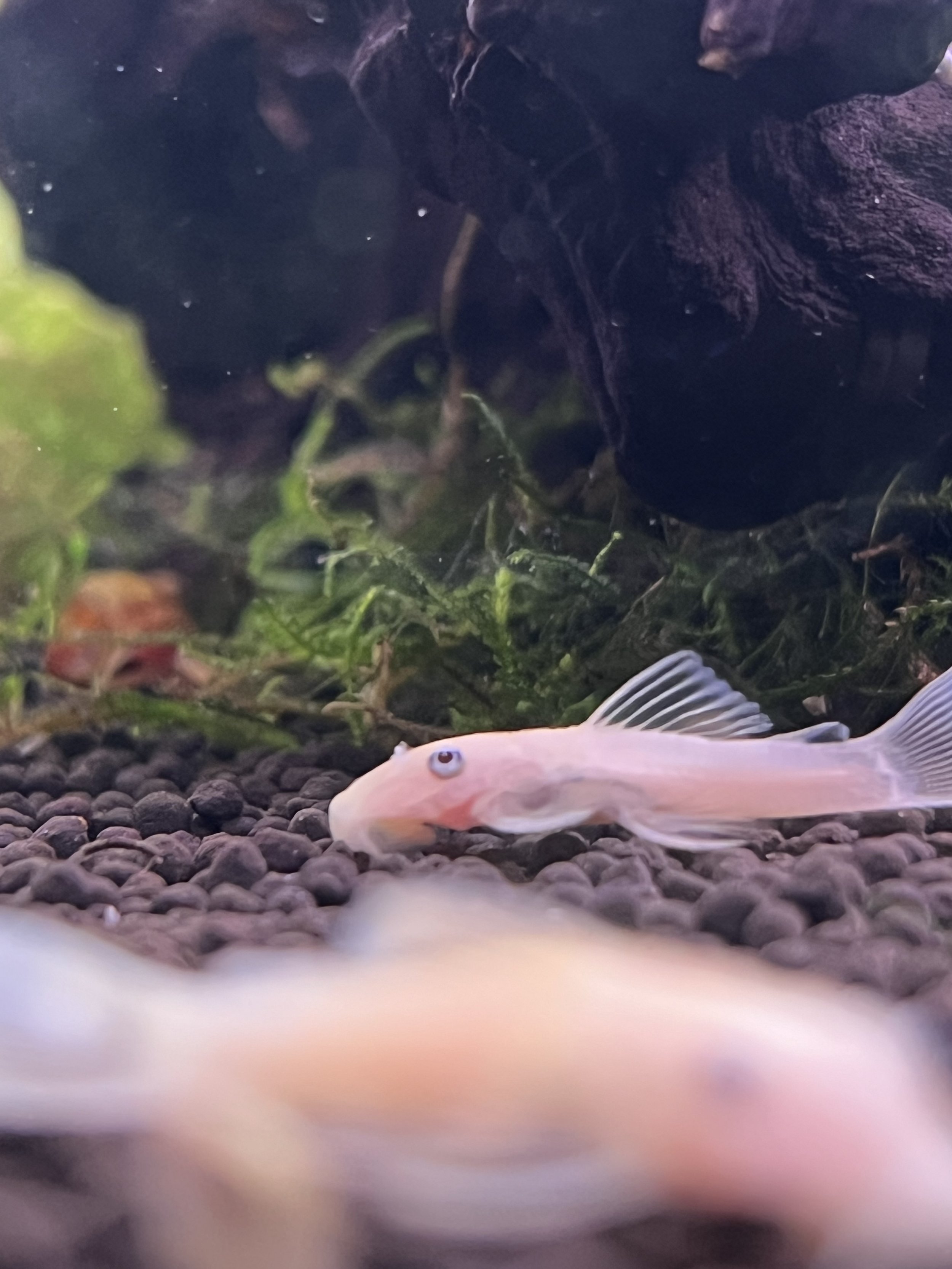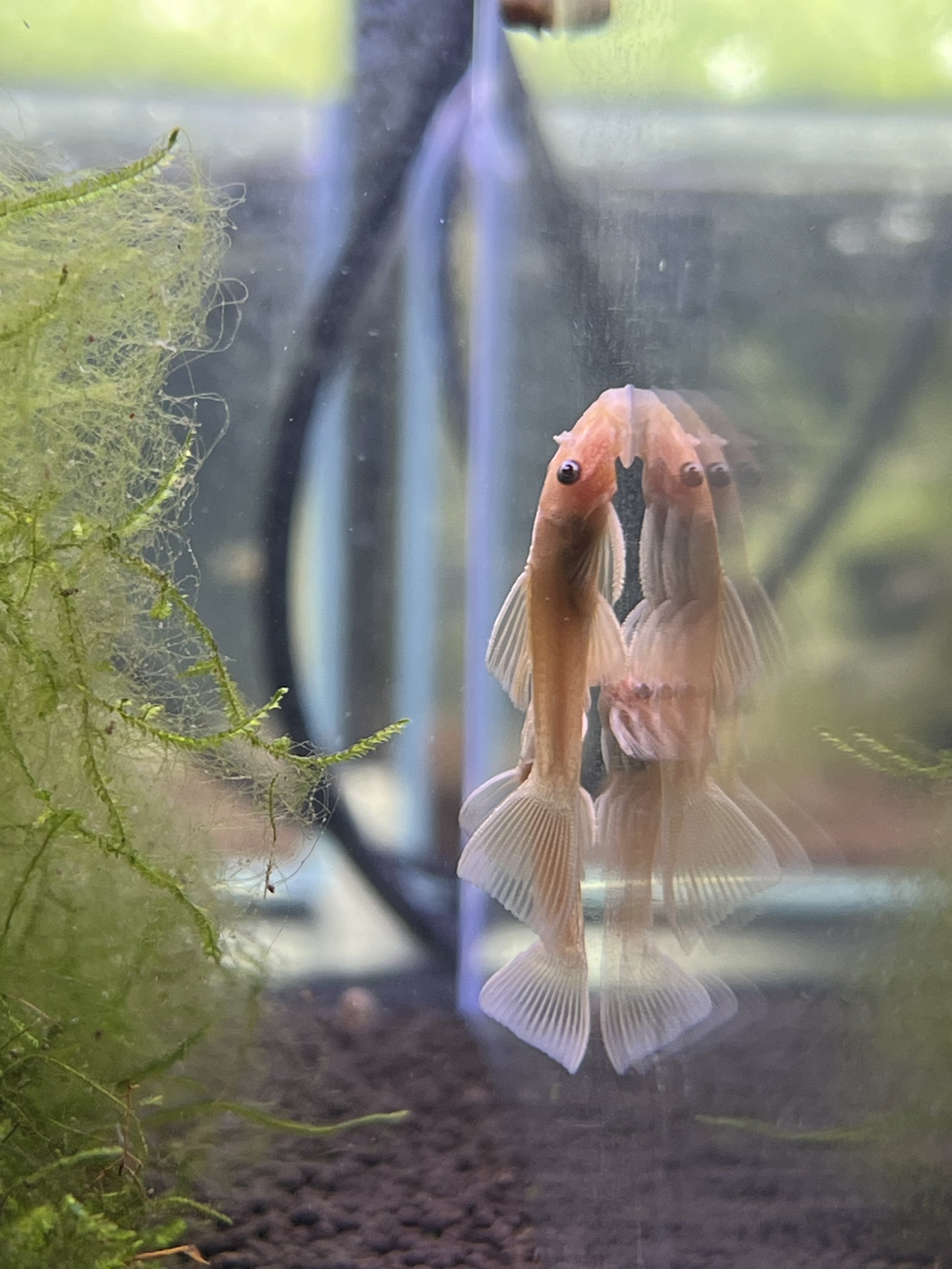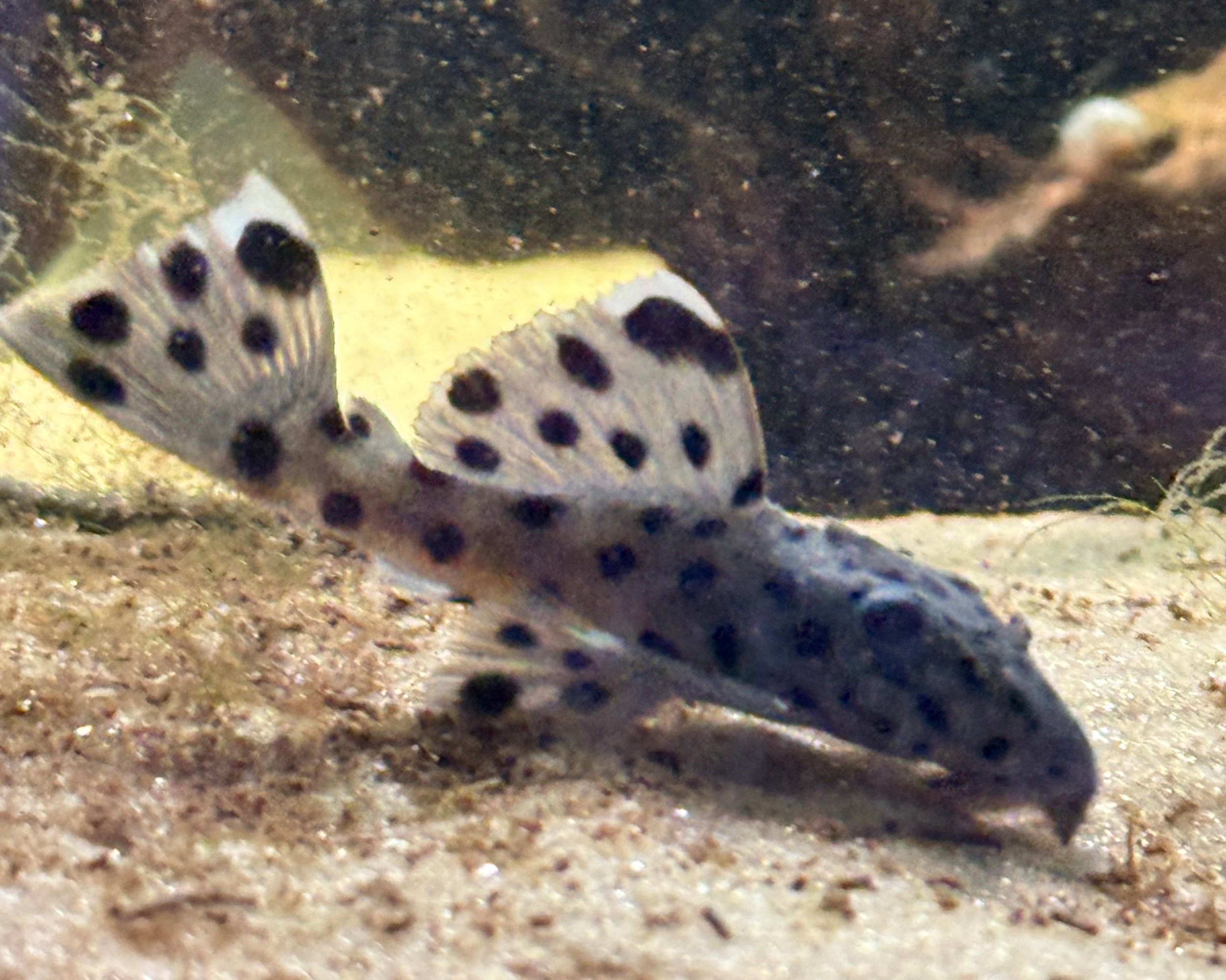 Image 1 of
Image 1 of


Blue Eye Blue Fin Panaque- L
The Blue Panaque Pleco, correctly known in the aquarium hobby as the L239 Pleco, is scientifically identified as Baryancistrus beggini. Native to the upper Rio Orinoco in Venezuela, this small, deep-bodied pleco is prized for its beautiful slate blue coloration, manageable size, and peaceful temperament, making it a popular choice for aquarists looking for a unique yet hardy Loricariid.
Physically, L239 plecos reach an adult size of about 3.5 to 4 inches (9 to 10 cm). Their entire body and fins are typically a rich, dark blue to bluish-gray color, sometimes with a slightly lighter edging along the dorsal and tail fins. Their compact shape, rounded head, and smooth body armor give them a distinct, sleek look compared to many other larger and more rugged pleco species.
In the aquarium, the Blue Panaque Pleco thrives in a tank of at least 20 to 30 gallons, though larger is better, especially when housed with other bottom dwellers. A tank with smooth rocks, caves, driftwood, and moderate to strong flow replicates their natural Orinoco habitat. They enjoy shaded areas and benefit from subdued lighting and plenty of cover.
Water parameters should be stable and clean. The ideal temperature range is 78 to 84°F (25 to 29°C), with a pH between 6.2 and 7.4. While relatively adaptable, L239 plecos do best in well-oxygenated water with moderate hardness and strong biological filtration. Regular water changes are important, as they are sensitive to nitrate buildup and poor water quality.
Feeding Baryancistrus beggini is straightforward. Though once believed to be a wood-eater like some other blue-colored plecos, this species is more omnivorous. They will graze on algae and biofilm but also require a diet supplemented with sinking carnivore pellets, high-quality algae wafers, and occasional treats like bloodworms, brine shrimp, or blanched vegetables (zucchini, spinach, etc.).
The Blue Panaque Pleco is peaceful and shy, making it compatible with other calm tankmates such as tetras, rasboras, dwarf cichlids, Corydoras, or other peaceful Loricariids. Territorial behavior is minimal, though multiple males may spar if hiding places are limited.
Breeding Baryancistrus beggini in captivity is extremely rare and undocumented in most hobby settings. Like other Baryancistrus, they are cave spawners in the wild, but exact breeding conditions and fry rearing strategies have not been widely established in home aquariums.
Overall, the L239 Blue Panaque Pleco (Baryancistrus beggini) is a visually stunning, low-maintenance pleco species ideal for intermediate to advanced aquarists. Its rare coloration, peaceful nature, and small adult size make it one of the most desirable dwarf plecos in the hobby.
The Blue Panaque Pleco, correctly known in the aquarium hobby as the L239 Pleco, is scientifically identified as Baryancistrus beggini. Native to the upper Rio Orinoco in Venezuela, this small, deep-bodied pleco is prized for its beautiful slate blue coloration, manageable size, and peaceful temperament, making it a popular choice for aquarists looking for a unique yet hardy Loricariid.
Physically, L239 plecos reach an adult size of about 3.5 to 4 inches (9 to 10 cm). Their entire body and fins are typically a rich, dark blue to bluish-gray color, sometimes with a slightly lighter edging along the dorsal and tail fins. Their compact shape, rounded head, and smooth body armor give them a distinct, sleek look compared to many other larger and more rugged pleco species.
In the aquarium, the Blue Panaque Pleco thrives in a tank of at least 20 to 30 gallons, though larger is better, especially when housed with other bottom dwellers. A tank with smooth rocks, caves, driftwood, and moderate to strong flow replicates their natural Orinoco habitat. They enjoy shaded areas and benefit from subdued lighting and plenty of cover.
Water parameters should be stable and clean. The ideal temperature range is 78 to 84°F (25 to 29°C), with a pH between 6.2 and 7.4. While relatively adaptable, L239 plecos do best in well-oxygenated water with moderate hardness and strong biological filtration. Regular water changes are important, as they are sensitive to nitrate buildup and poor water quality.
Feeding Baryancistrus beggini is straightforward. Though once believed to be a wood-eater like some other blue-colored plecos, this species is more omnivorous. They will graze on algae and biofilm but also require a diet supplemented with sinking carnivore pellets, high-quality algae wafers, and occasional treats like bloodworms, brine shrimp, or blanched vegetables (zucchini, spinach, etc.).
The Blue Panaque Pleco is peaceful and shy, making it compatible with other calm tankmates such as tetras, rasboras, dwarf cichlids, Corydoras, or other peaceful Loricariids. Territorial behavior is minimal, though multiple males may spar if hiding places are limited.
Breeding Baryancistrus beggini in captivity is extremely rare and undocumented in most hobby settings. Like other Baryancistrus, they are cave spawners in the wild, but exact breeding conditions and fry rearing strategies have not been widely established in home aquariums.
Overall, the L239 Blue Panaque Pleco (Baryancistrus beggini) is a visually stunning, low-maintenance pleco species ideal for intermediate to advanced aquarists. Its rare coloration, peaceful nature, and small adult size make it one of the most desirable dwarf plecos in the hobby.
The Blue Panaque Pleco, correctly known in the aquarium hobby as the L239 Pleco, is scientifically identified as Baryancistrus beggini. Native to the upper Rio Orinoco in Venezuela, this small, deep-bodied pleco is prized for its beautiful slate blue coloration, manageable size, and peaceful temperament, making it a popular choice for aquarists looking for a unique yet hardy Loricariid.
Physically, L239 plecos reach an adult size of about 3.5 to 4 inches (9 to 10 cm). Their entire body and fins are typically a rich, dark blue to bluish-gray color, sometimes with a slightly lighter edging along the dorsal and tail fins. Their compact shape, rounded head, and smooth body armor give them a distinct, sleek look compared to many other larger and more rugged pleco species.
In the aquarium, the Blue Panaque Pleco thrives in a tank of at least 20 to 30 gallons, though larger is better, especially when housed with other bottom dwellers. A tank with smooth rocks, caves, driftwood, and moderate to strong flow replicates their natural Orinoco habitat. They enjoy shaded areas and benefit from subdued lighting and plenty of cover.
Water parameters should be stable and clean. The ideal temperature range is 78 to 84°F (25 to 29°C), with a pH between 6.2 and 7.4. While relatively adaptable, L239 plecos do best in well-oxygenated water with moderate hardness and strong biological filtration. Regular water changes are important, as they are sensitive to nitrate buildup and poor water quality.
Feeding Baryancistrus beggini is straightforward. Though once believed to be a wood-eater like some other blue-colored plecos, this species is more omnivorous. They will graze on algae and biofilm but also require a diet supplemented with sinking carnivore pellets, high-quality algae wafers, and occasional treats like bloodworms, brine shrimp, or blanched vegetables (zucchini, spinach, etc.).
The Blue Panaque Pleco is peaceful and shy, making it compatible with other calm tankmates such as tetras, rasboras, dwarf cichlids, Corydoras, or other peaceful Loricariids. Territorial behavior is minimal, though multiple males may spar if hiding places are limited.
Breeding Baryancistrus beggini in captivity is extremely rare and undocumented in most hobby settings. Like other Baryancistrus, they are cave spawners in the wild, but exact breeding conditions and fry rearing strategies have not been widely established in home aquariums.
Overall, the L239 Blue Panaque Pleco (Baryancistrus beggini) is a visually stunning, low-maintenance pleco species ideal for intermediate to advanced aquarists. Its rare coloration, peaceful nature, and small adult size make it one of the most desirable dwarf plecos in the hobby.






